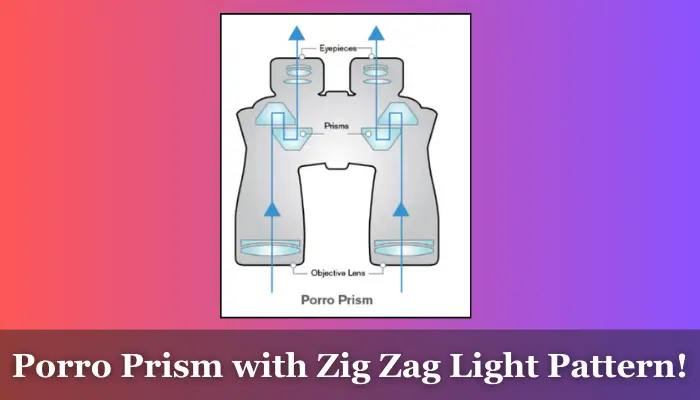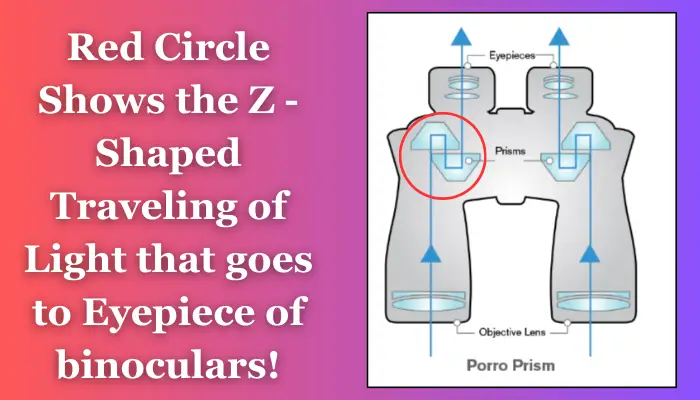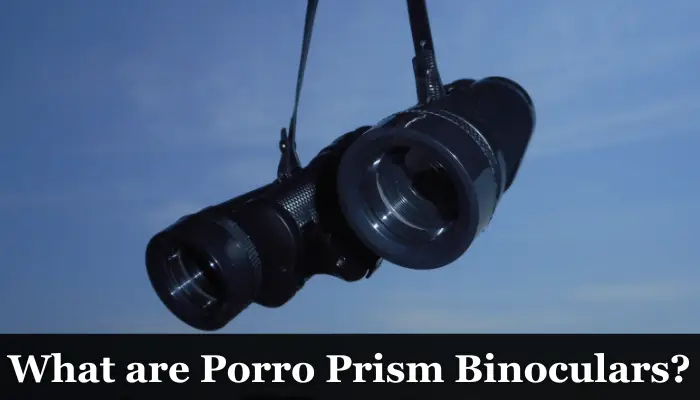This post may contain affiliate links which means I may receive a small commission for purchases made through the links. Learn More
In the previous article, we talked about the roof prism. But guess what? There’s a whole other category of binoculars that don’t use roof prism yet are very effective in giving clear and shaper visuals and those are known as Porro prism binoculars.
So, let’s discuss: what are Porro prism binoculars? The binoculars that consist of porro prisms are called porro prism binoculars. These binos are a bit more bulky but offer better depth in the visuals. Keep in mind that the Porro prism binos are more budget-friendly options as compared to roof prism ones.
I know the fact that understanding prism is a bit hard – but don’t worry as I will try my best to explain everything in the easiest words, and way. So, let’s get started.
Related Article: What Are Roof Prism Binoculars?
Introduction to Porro Prism Binoculars
The Porro prism was named ‘Porro’ due to the founder’s name ‘‘Ignazio Porro’’. The usage of this prism in binoculars offers better depth perception, and you tend to feel that everything is happening right in front of you. Obviously, it brings visuals close to reality.
However, the prism system makes the binoculars more bulky, and bigger sized. This is an issue but keep in mind that Porro prism binoculars are usually inexpensive which makes them popular options. Porro prism binos are totally opposite to those of roof prism binoculars.
Working Mechanism of Porro Prism Binoculars

First of all, the objective lens captures the light from the surroundings. This is common in all types of binoculars. But the objective is to send an inverted image and focus it on the prisms. The role of the prism is to make the image right side up corrected so that the user can see everything clearly.
The Porro prism system does not help in making the light travel in a straight line. Instead, the light travels in a zigzag pattern. There are two prisms used in one barrel which are placed back to back. The light coming from the objective lens is directed to the first prism which is a right-angle prism.
When light touches this prism, then it directly gets changed to a 90-degree angle. It indicates that light no more travels in a streamlined or straight direction and moves at a 90-degree angle. This directed light goes to the second prism which is also Porro.
When the light reaches the second prism, the light direction again gets changed at a 90-degree angle and the light now travels towards the eyepiece where the users see magnified images. These prisms actually correct or reorient the image so that the user sees perfect clear visuals.

It is interesting to note that the light makes a zig-zag pattern (Z-shaped) while traveling from one prism and then going at a 90-degree angle to touch the second prism which is shown in the images above. Due to the zigzag movement of light rays, the binocular body has to be big or bulky.
Role of Porro Prism on the Optical Performance
As I said earlier the Porro prism does not allow the light to travel in one straight line. Instead, it travels in a zigzag pattern. Due to these patterns, more distance remains between the eyepiece and the objective lens. The size of binoculars gets bigger.
Due to the distance between the eyepiece and the objective lens size, the image depth gets better. You tend to see a very detailed, and in-depth image of the target. This enhanced depth perception can make it easier to gauge distances and dimensions when observing objects at a distance.
Without the Porro prism, that depth perfection would not have been ideal. In fact, due to the distance between the eyepiece, and the objective lens, you see a better and wider field of view which is also a good thing, especially for hunters.
Advantages of Porro Prism in Binoculars
In the above-given section, I have talked about the mechanism and working principles of the Porro prism in binoculars. But Let’s talk about some potential benefits that you get by using the roof prism binoculars.
1- Enhanced depth perception
As I have explained in the above section, the eyepiece and the objective lens size remain farther from each other. So, the depth perception gets better and you end up seeing the objects more clearly and sharply. The enhanced depth perception also helps you see the objects that are very far away from you.
In fact, the Porro prism in binoculars improves optical performance. You tend to see a better field of view and excellent three-dimensional perception which ensures that you feel better when seeing something with the binoculars.
2- Affordable Option
The porro prism is inexpensive, and using it in the binoculars is also cost effective which makes it a popular option to be used in the binoculars. Although there are many limitations of Porro Prism, it offers decent performance and is also available at affordable pricing making it a good option for binocular manufacturers.
Keep in mind that there are different people out there who have different budgets. The manufacturer uses the Porro prism in the binoculars and produces inexpensive binos with slightly compromised optical performance for those people who are budget-conscious. However, if you want ideal optical performance, you should choose roof prism binoculars.
Limitations or Drawbacks of Porro Prism Binoculars
In the section above, I have explained the benefits of using the Porro prism in the binoculars. But hold on! There are drawbacks as well. I would love you to know about those limitations so that you don’t feel confused while making your final decision about choosing the Porro Prism binoculars.
1- Durability Issue due to Spacing Between Prisms
Durability is something that everyone loves in binoculars. But when you choose Porro prism binoculars then you actually get compromised durability. The reason is that there remains a distance between the prisms in the porro prism binoculars.
Although this distance is not too much it is enough to dislocate the position of the prism when the binoculars fall from height or undergo any shocks.
Imagine yourself using binoculars and suddenly the binoculars fall off your hands. Due to the fall and shock, the prism’s positions can be altered as a result you won’t be able to see anything clearly with binos. You will have to get your binoculars repaired by a professional mechanic.
This is a big issue but it is not present in roof prism binoculars. In the roof prism binoculars, the prisms are clamped together, and even if binocular falls they (prisms) don’t get dislocated or separated from each other. This is the biggest drawback that you are going to face if you choose porro prism binoculars
2- Size and Shape
In the Porro prism binoculars, the light does not travel in one straight line. In fact, it travels in zigzag patterns which makes the prism system very complex. For functioning, the prism requires more space which makes the binoculars bulky and bigger in size. The bigger size of the binoculars makes the shape less user friendly which is a big issue for those people who love to carry compact and lightweight binoculars.
3- Potentially Less Modern Aesthetics
As I said before the Porro prisms require more space for functionality which makes the overall binoculars more bulky and bigger sized. Due to the bulkier shape, the overall aesthetics of the binoculars are affected. If you have noticed, all the Porro prism binoculars are similar and don’t look attractive or sleek. The roof prism binos are more sleek and modern shape.
Conclusion
I hope that you now got the basic information about the Porro prism binoculars, and how they actually work. Keep in mind that the Porro prism binoculars are inexpensive, but they are never perfect in terms of performance. If you have a tight budget, you can try Porro prism binos, however, in case you want to enjoy excellent performance, you should not go with Porro prism binoculars as they are bulkier and bigger in size.

I’m a passionate outdoor activist who has got special love for optics. The school studies in optical mechanics and the travelling experience has made me an expert in optics like binoculars, scopes, and other devices. Stay connected with us for in-depth knowledge!

